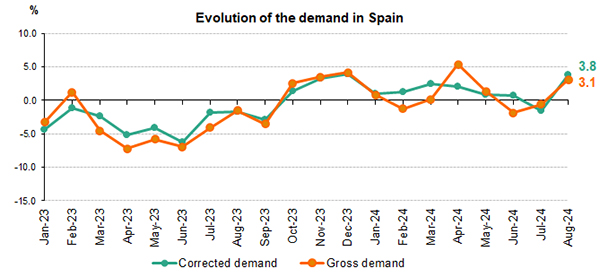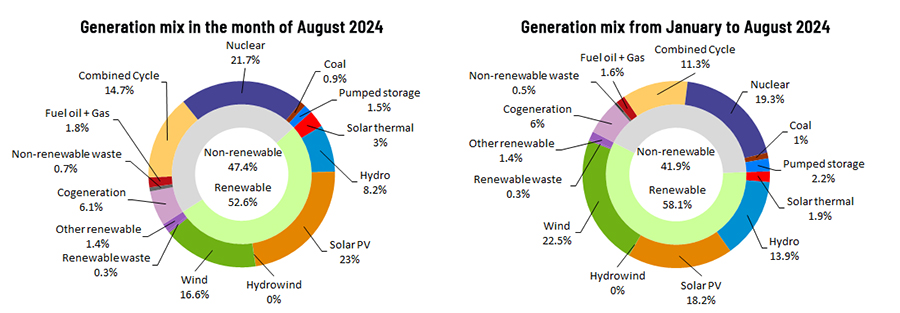For 40 years, we've been driving our country's economic and social progress. Four decades shaping Spain.
Electricity demand in Spain increases by 3.8% in August
- For the fourth month in a row, solar photovoltaic energy leads the domestic generation mix at 23% of the total.
- Monthly production using renewable energies in Spain accounted for 52.6%, and technologies that do not emit CO2 equivalents reached 75.4%.

Domestic electricity demand rose by 3.8% in August compared to the same month last year, after adjusting for the effects of temperature and working patterns. This represents an estimated gross demand of 22,347 GWh, 3.1% higher than in August 2023.

From January to August 2024, Spain recorded a total demand of 165,806 GWh, 0.8% higher than in the same period in 2023. After adjusting for the effects of working patterns and temperatures, demand was 1.3% higher compared to the same period of the previous year.
This month, renewables generated 12,341 GWh, 13.6% more than in August 2023, reaching a share of 52.6% of the total, making this the fourth month in a row in which solar photovoltaic energy leads the Spanish mix, with 23% of the total. During this month, this technology produced 5,400 GWh, representing a 20.8% increase compared to August 2023.
According to provisional data currently available, solar photovoltaic led nuclear (21.7%) and wind (16.6%), in terms of technologies with the highest production in August.
With this boost from renewables, 75.4% of the electricity produced in Spain in August 2024 was free of CO2 equivalent emissions.

Demand in the Peninsula increased by 3.9%
Peninsular demand was 3.9% higher than in August 2023, after factoring in the effects of working patterns and temperatures. In gross terms, demand this month was 20,776 GWh, 3.2% higher than in the same month last year.
From January to August this year, aggregate demand in the mainland was 155,590 GWh, 0.9% higher than that recorded in 2023. After adjusting for the effects of working patterns and temperatures, demand was 1.3% compared to the same period of the previous year.
Mainland renewables as a whole generated 54.4% of the total in August, according to provisional data available today, which show production of 12,015 GWh, 13.5% more than in the same month last year. Emission-free technologies accounted for 78.7% of the total.
The peninsular generation structure in August was also led by solar photovoltaic power, which was responsible for 24.1% of the total, producing 5,309 GWh during the month, 20.9% more than in August 2023.
The electricity system in the Balearic and Canary Islands
In the Balearic Islands, electricity demand in August was 3.5% higher than in the same month in 2023, after considering the effects of working hours and temperatures. Gross demand is estimated at 735,905 MWh, 4.4% more than in August last year. From January to August 2024, gross demand in the Balearic Islands is estimated at 4,138,923 MWh, 0.3% less than in the same period of 2023.
In terms of generation, combined cycle, which accounted for 64.2% of the energy produced in the Balearic Islands, was the leading source this month. In the Balearic Islands, renewable energy generation, without CO2 equivalent emissions, accounted for 13.1% of the total. Renewable production in the Balearic Islands grew by 21% in August compared to the same month last year.
Additionally, this August, the submarine link between the Peninsular and Mallorca helped cover 25.4% of the Balearic Islands' electricity demand.
Meanwhile, in the Canary Islands, electricity demand grew by 0.4% compared to the same month in 2023, adjusting for the effects of working patterns and temperatures. Gross demand was 791,977 MWh, representing a 1.3% decrease. In the first eight months of 2024, demand in the Canary Islands was estimated at 5,813,443 MWh, 1.3% more than in the same period of 2023.
In terms of electricity generation in the Canary Islands, combined cycle, at 34.6% of the total, was also the leading source in August. Renewables and emission-free technologies accounted for 32.1% of production by generating 254,015 MWh, the highest amount ever recorded in the archipelago. Wind power contributed 27% to the total this month, achieving a 19.8% increase compared to its production in August 2023.
Please see our Daily balance report for further information on the national, peninsular, Balearic Islands and Canary Islands electricity systems up to the end of August.
Downloads












